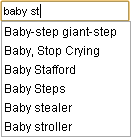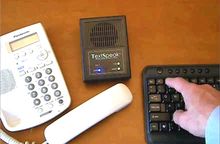
Assistive technology (AT) is a term for assistive, adaptive, and rehabilitative devices for people with disabilities and the elderly. Disabled people often have difficulty performing activities of daily living (ADLs) independently, or even with assistance. ADLs are self-care activities that include toileting, mobility (ambulation), eating, bathing, dressing, grooming, and personal device care. Assistive technology can ameliorate the effects of disabilities that limit the ability to perform ADLs. Assistive technology promotes greater independence by enabling people to perform tasks they were formerly unable to accomplish, or had great difficulty accomplishing, by providing enhancements to, or changing methods of interacting with, the technology needed to accomplish such tasks. For example, wheelchairs provide independent mobility for those who cannot walk, while assistive eating devices can enable people who cannot feed themselves to do so. Due to assistive technology, disabled people have an opportunity of a more positive and easygoing lifestyle, with an increase in "social participation", "security and control", and a greater chance to "reduce institutional costs without significantly increasing household expenses." In schools, assistive technology can be critical in allowing students with disabilities to access the general education curriculum. Students who experience challenges writing or keyboarding, for example, can use voice recognition software instead. Assistive technologies assist people who are recovering from strokes and people who have sustained injuries that affect their daily tasks.

Expressive aphasia is a type of aphasia characterized by partial loss of the ability to produce language, although comprehension generally remains intact. A person with expressive aphasia will exhibit effortful speech. Speech generally includes important content words but leaves out function words that have more grammatical significance than physical meaning, such as prepositions and articles. This is known as "telegraphic speech". The person's intended message may still be understood, but their sentence will not be grammatically correct. In very severe forms of expressive aphasia, a person may only speak using single word utterances. Typically, comprehension is mildly to moderately impaired in expressive aphasia due to difficulty understanding complex grammar.
Makaton is a communication tool with speech, signs, and symbols to enable people with disabilities or learning disabilities to communicate. Makaton supports the development of essential communication skills such as attention, listening, comprehension, memory and expressive speech and language. The Makaton language programme has been used with individuals who have cognitive impairments, autism, Down syndrome, specific language impairment, multisensory impairment and acquired neurological disorders that have negatively affected the ability to communicate, including stroke and dementia patients.

A screen reader is a form of assistive technology (AT) that renders text and image content as speech or braille output. Screen readers are essential to people who are blind, and are useful to people who are visually impaired, illiterate, or have a learning disability. Screen readers are software applications that attempt to convey what people with normal eyesight see on a display to their users via non-visual means, like text-to-speech, sound icons, or a braille device. They do this by applying a wide variety of techniques that include, for example, interacting with dedicated accessibility APIs, using various operating system features, and employing hooking techniques.

Autocomplete, or word completion, is a feature in which an application predicts the rest of a word a user is typing. In Android and iOS smartphones, this is called predictive text. In graphical user interfaces, users can typically press the tab key to accept a suggestion or the down arrow key to accept one of several.
Reading for special needs has become an area of interest as the understanding of reading has improved. Teaching children with special needs how to read was not historically pursued due to perspectives of a Reading Readiness model. This model assumes that a reader must learn to read in a hierarchical manner such that one skill must be mastered before learning the next skill. This approach often led to teaching sub-skills of reading in a decontextualized manner. This style of teaching made it difficult for children to master these early skills, and as a result, did not advance to more advanced literacy instruction and often continued to receive age-inappropriate instruction.

Augmentative and alternative communication (AAC) encompasses the communication methods used to supplement or replace speech or writing for those with impairments in the production or comprehension of spoken or written language. AAC is used by those with a wide range of speech and language impairments, including congenital impairments such as cerebral palsy, intellectual impairment and autism, and acquired conditions such as amyotrophic lateral sclerosis and Parkinson's disease. AAC can be a permanent addition to a person's communication or a temporary aid. Stephen Hawking, probably the best-known user of AAC, had amyotrophic lateral sclerosis, and communicated through a speech-generating device.
The Phraselator is a weatherproof handheld language translation device developed by Applied Data Systems and VoxTec, a former division of the military contractor Marine Acoustics, located in Annapolis, Maryland, USA. It was designed to serve as a handheld computer device that translates English into one of 40 different languages.
Tangible symbols are a type of augmentative and alternative communication (AAC) that uses objects or pictures that share a perceptual relationship with the items they represent as symbols. A tangible symbol's relation to the item it represents is perceptually obvious and concrete – the visual or tactile properties of the symbol resemble the intended item. Tangible Symbols can easily be manipulated and are most strongly associated with the sense of touch. These symbols can be used by individuals who are not able to communicate using speech or other abstract symbol systems, such as sign language. However, for those who have the ability to communicate using speech, learning to use tangible symbols does not hinder further developing acquisition of natural speech and/or language development, and may even facilitate it.
Mobile translation is any electronic device or software application that provides audio translation. The concept includes any handheld electronic device that is specifically designed for audio translation. It also includes any machine translation service or software application for hand-held devices, including mobile telephones, Pocket PCs, and PDAs. Mobile translation provides hand-held device users with the advantage of instantaneous and non-mediated translation from one human language to another, usually against a service fee that is, nevertheless, significantly smaller than a human translator charges.
David R. Beukelman was an American speech-language pathologist who specialized in augmentative and alternative communication and communication disorders associated with neurological conditions. He was the Barkley Professor Emeritus of Communication Disorders at the University of Nebraska-Lincoln and used to be the Director of Research and Education of the Communication Disorders Division, Munroe/Meyer Institute of Genetics and Rehabilitation, University of Nebraska Medical Center, Omaha, Nebraska.
Speech and language impairment are basic categories that might be drawn in issues of communication involve hearing, speech, language, and fluency.
A letter board may refer to two devices.
The International Society for Augmentative and Alternative Communication (ISAAC) was founded in May 1983 in East Lansing, Michigan, United States. Its stated purpose is to improve the communication abilities and quality of life of individuals with complex communication needs who use augmentative and alternative communication (AAC). ISAAC provides information about AAC services, policies and activities around the world thorough various publications and their website. The society publishes a journal and various other publications, organizes biennial conferences, promotes research on AAC use and AAC development as well as implements various projects.
Partner-assisted scanning or listener-assisted scanning is an augmentative and alternative communication technique used to enable a person with severe speech impairments to communicate. The approach is used with individuals who, due to sickness or disability, have severe motor impairments and good memory and attention skills. It is used as an alternative to direct access to symbols, pictures, or speech generating devices when these are not used.
Semantic compaction, (Minspeak), conceptually described as polysemic (multi-meaning) iconic encoding, is one of the three ways to represent language in Augmentative and alternative communication (AAC). It is a system utilized in AAC devices in which sequences of icons are combined in order to form a word or a phrase. The goal is to increase independent communication in individuals who cannot use speech. Minspeak is the only patented system for Semantic Compaction and is based on multi-meaning icons that code vocabulary in short sequences determined by rule-driven patterns. Minspeak has been used with both children and adults with various disabilities, including cerebral palsy, motor speech disorders, developmental disabilities, autism spectrum disorder, and adult onset disabilities such as Amyotrophic Lateral Sclerosis (ALS).
Switch access scanning is an indirect selection technique, used with switch access by an assistive technology user, including those who use augmentative and alternative communication (AAC), to choose items from the selection set. Unlike direct selection, a scanner can only make selections when the scanning indicator of the electronic device is on the desired choice. The scanning indicator moves through items by highlighting each item on the screen, or by announcing each item via voice output, and then the user activates a switch to select the item. The speed and pattern of scanning, as well as the way items are selected, are individualized to the physical, visual and cognitive capabilities of the user. While there may be different reasons for using scanning, the most common is a physical disability resulting in reduced motor control for direct selection. Communication during scanning is slower and less efficient than direct selection and scanning requires more cognitive skill. Scanning using technology has an advantage allows the user to be independent in controlling the assistive technology for those with only one voluntary movement.

Lightwriters are a type of speech-generating device. The person who cannot speak types a message on the keyboard, and this message is displayed on two displays, one facing the user and a second outfacing display facing the communication partner or partners. A speech synthesiser is also used to provide speech output, and some models offer the facility to connect to a printer to provide printed output.
Key word signing is a technique of simultaneous communication whereby the communication partner of the user will use both natural speech and also produce signs for the words that carry the most important information. Key word signing puts emphasis on the pertinent words in a sentence or a phrase, rather than signing every word like you would for American Sign Language (ASL). For example, if someone said, "Go wash your hands" the key words that would be signed would be "wash" and "hand".

Spoken is a mobile application and augmentative and alternative communication (AAC) tool launched in 2019. The app was designed to aid individuals with speech and language impairments like aphasia or nonverbal autism, using a combination of symbols, text, and voice output.















